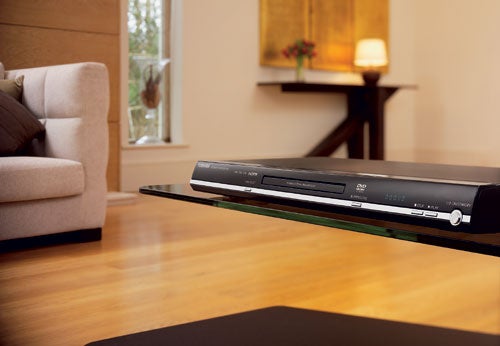Toshiba SD-370E Upscaling DVD Player Review
Toshiba SD-370E Upscaling DVD Player
If you want to make the most of your DVD collection, you don't have to pay the earth.

Verdict
Key Specifications
- Review Price: £59.99
DVD has been around for just over a decade, and most of us have built up a pretty impressive collection of discs. But the introduction of HD Ready TVs, Blu-ray and HD DVD has presented us with a dilemma – should we upgrade to a high-definition player and start our collections from scratch, or should we make the most of our existing standard-def discs?
For most people the latter is the only option, given how expensive the former would be, and that’s where upscaling DVD players come in. They take the 576 lines of picture information stored on a DVD and boost the pixel count up to 1,280 x 720 or 1,920 x 1,080 using clever interpolation techniques, more closely matching the resolutions of HD Ready flatpanel TVs and projectors.
But the best part is that this feature is no longer reserved for high-end players. You can now pick up an upscaling DVD deck for peanuts, even ones from big name brands as this £60 player from Toshiba demonstrates. The SD-370E boasts upscaling to 720p and 1080i (but not 1080p, which would have been remarkable for the money) and also boasts DivX playback, including v6 and video-on-demand (with a registration code).
![]()
At just 40mm high, the player is the dictionary definition of slim, which makes it ideal for slotting into tight spaces under your TV or in the bedroom. The seductive black styling with a dashing silver stripe is designed to complement Toshiba’s HD DVD decks and Regza LCD TVs, and confirms that when it comes to home entertainment kit, black is definitely the new silver. We were initially concerned by how light the deck is, but this is pretty much par of the course with sub-£100 DVD decks these days, thanks to the use of smaller and more efficient internal components.
Scoot round the back and you’ll find a decent but fairly uninspiring set of sockets. The undoubted highlight is HDMI output, which is the connection you’ll need to get those upscaled pictures. It’s joined by progressive-scan capable component video phonos, a single Scart socket offering RGB and composite video output, plus composite video and a pair of phonos for analogue stereo audio output.
HDMI upscaling may head the bill when it comes to features, but there are plenty of other tricks that make day-to-day movie viewing a slick experience. There’s a 100x search mode, which comes in very handy for skipping the irritating ‘piracy is a crime’ trailer, plus a decent-quality three stage zoom for getting up close and personal with your favourite scenes.
Next up is the Enhanced Picture Mode (EPM), which allows you to adjust the brightness and sharpness of the image. Increasing the latter introduces a fairly severe white line around edges, so keep it at a low level. This is joined by Enhanced Audio Mode (EAM), which lends a ‘3D effect’ to stereo sound. The deck will also play JPEG and MP3 files but curiously not WMA, and it plays every type of recordable DVD except DVD-RAM. Dolby Digital and DTS bitstream output complete the feature line-up.
Picture quality is excellent on the whole. Keeping it in the family, we rigged up the SD-370E to a Toshiba 42C3030D LCD TV, set it to 576p output (DVD’s native resolution) and let it rip with the Region 2 King Kong disc. In this setting, the TV does the upscaling work, and generally the results are very enjoyable. Images seem rich and cinematic, with dynamic colour reproduction and a pleasing amount of detail in the picture.
These elements combine to thrilling effect in the CG-heavy Kong Vs T-Rex scrap. The different shades of green in the surrounding jungle look strong yet natural, while fine details like Kong’s fur or the T-Rex’s textured skin are sharply rendered.
Switch to 720p and the difference isn’t immediately apparent – you get the same levels of detail and forceful colour tones. But what we did notice upon close inspection is that pictures seem fractionally cleaner and less ‘processed’ using the player’s upscaling chip compared with the TV’s. As Ann backs away from the T-Rex after tumbling down the precipice, the densely detailed jungle background seems a touch more stable than the 576p setting. However, the difference is minimal – pictures are impressive either way. 
1080i pictures show no real signs of strain despite being upscaled by the player then downscaled by the TV. Don’t go expecting miracles though – the results are nowhere near as mind-blowing as true high-definition sources like Blu-ray, HD DVD or Sky HD.
DivX files play back smoothly without any glitches or stuttering, but the quality depends on the encoding. High-resolution JPEGs don’t fare so well on our LCD screen – they look grainy and suffer from jagged edges and indistinct detail reproduction. We suggest sticking with your PC.
As for audio, the quality of Dolby Digital and DTS soundtracks largely depends on your sound system, but the deck transfers the digital bitstream with all the bits intact. Stereo sound playback from the analogue stereo phonos is also hugely enjoyable with a wide range of material.
”’Verdict”’
It may lack 1080p upscaling and DVD-A/SACD playback, and obviously it’s not multiregion from the box, but on the whole the SD-370 is an excellent little player. Terrific picture quality, including solid upscaling, makes it a surprisingly accomplished performer, while the sleek, slimline design is a bonus. But the best part is that you get all this for a wallet-friendly price tag, giving hi-def refuseniks a cost-effective way to prolong the life of their DVD collection.
Trusted Score
Score in detail
-
Performance 8
-
Features 7
-
Value 9

